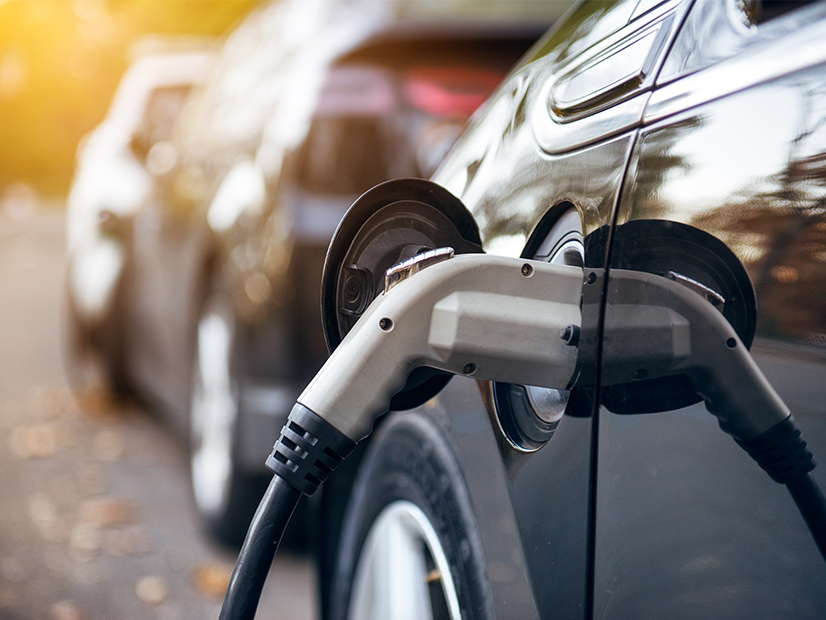EPA on Tuesday announced it will propose new emission standards for cars and trucks that could lead to two-thirds of the total light-duty vehicles and 46% of medium-duty vehicles sold in 2032 being electric.
A second set of standards focuses on heavy-duty vehicles such as buses, construction equipment and utility bucket trucks. Both standards would go into place starting in model year 2027 and are built on standards already in place through 2026 that limit the amount of carbon dioxide vehicles can emit.
During a press conference Tuesday, EPA officials were tight-lipped about what exactly those amounts would be, but one official mentioned that light-duty vehicles would be limited to 82 g/mile by 2032. The standards would not mandate any specific technologies, and other carbon-cutting technologies outside of batteries will likely benefit from them, but experts outside the agency said that electric vehicles are the cheapest now.
Since President Biden took office, the number of EV sales has tripled, while the number of available models has doubled, White House Climate Adviser Ali Zaidi said at the press conference. EPA officials said the standards would improve air quality for communities around the country and avoid nearly 10 billion tons of carbon emissions, more than twice the entire country emitted last year.
They also said that they will cut fuel and maintenance costs, saving customers $12,000 over the lifetime of a light-duty vehicle as compared to a vehicle not subject to the new standards. Oil imports would be cut by about $20 billion, and the agency estimates the total benefits of the standards would exceed costs by at least $1 trillion.
The proposal aligns with commitments made by car manufacturers and U.S. states as they plan to accelerate clean technologies to include EVs as a growing part of future product lines, EPA said.
Legal and Supply Chain Challenges
The standards were developed using a process that EPA has used before when it sought to improve the mileage standards of internal combustion engines, which led experts on a call earlier in the day hosted by Environmental Defense Fund to say they should withstand any legal challenges.
“These regulations will reflect, in my view, the single most important regulatory initiative by the Biden administration to combat climate change to really reduce the worst outcomes of climate change,” Margo Oge, a fellow with ClimateWorks Foundation, said on the call.
Getting to nearly 70% EVs in the next decade is going to be challenge, but the industry was already heading this way, and the Inflation Reduction Act has funding that encourages more of the supply chain needed to build all those cars to move to domestic sources, said Oge, who worked at EPA for several decades until the Obama administration.
“We’re going to see massive, massive effort in the U.S. … to invest in all these elements,” she added. “The critical minerals are important. Battery components are important. Manufacturing facilities are important.”
There are already about 75 facilities across 24 states that are involved in the battery and critical materials supply chain, Oge said.
Advanced Energy United Director of Transportation Ryan Gallentine agreed that it was important for the U.S. to ensure its supply chains are increasingly domestic, or at least in friendly nations.
“I think ultimately, at least in the short term, it needs to be an all-of-the-above strategy for sourcing these materials,” Gallentine said in an interview.
The standards are being put in place in service of the overarching goal of limiting the worst impacts of climate change, and global politics should be put aside in furtherance of that overall goal as much as possible, he added.
Can the Grid Handle the New Demand?
Also on Tuesday, NERC, WECC and the California Mobility Center released an analysis of supplying EVs power, which did not take into account the new standards (projecting only as much as 30% of new light-duty vehicles being plug-ins by 2050) but discussed some of the power sectors challenges and opportunities. (See related story, NERC, WECC Outline EV Charging Reliability Impacts.)
The analysis laid out a number of issues with the distribution system’s capability of handling the new loads and other potential problems, but it noted that with enough planning, plug-in vehicles actually could benefit the grid by providing key services such as frequency response.
AEU’s Gallentine agreed with that assessment. Some changes to permitting laws to help expand the bulk power system on the federal side would help, but much of the work is going to be left to the states as they oversee the distribution system, he said.
“At the state level, we’ve been advocating for utility business model reform that would basically allow utilities to build in anticipation of that,” said Gallentine.
Utilities should be able to plan their systems to meet the needs of electrifying fleets and areas such as highway rest stops, where many EVs would charge at once, before that load shows up, he said.
“We need a lot of careful planning and coordination from folks at the state level to tackle the power-supply question,” Gallentine said. “And my concern is that states that aren’t doing that are going to end up with a much more expensive and less efficient deployment of this. I would say whether or not your state is supportive of EV policy, they owe it to all ratepayers to do this in a way that isn’t going to be expensive.”


